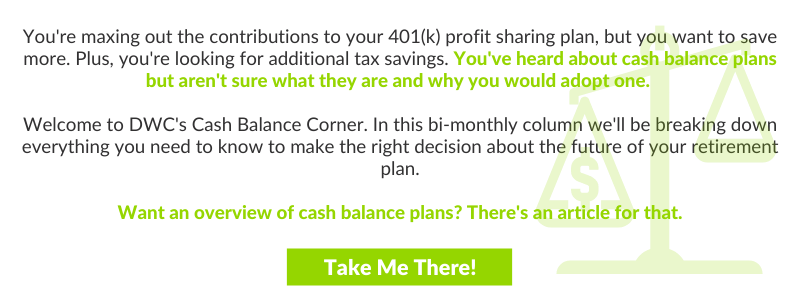
Welcome to Cash Balance Corner! We've created this bi-monthly column to teach you everything you need to know about defined benefit and cash balance plans in order to help you make the best possible decisions about your company retirement plan. Because a cash balance plan is a type of defined benefit (DB) plan, we'll start with a primer on the differences between DB plans and defined contribution (DC) plans.
As the names suggest, the key difference between DB and DC plans lies in how the eventual retirement benefit is determined. In a DC plan (think 401(k) or profit sharing plan), the design of the plan defines the contributions that go in. Contributions can typically be made by employees and by the company. Some are discretionary (employee deferrals and profit sharing contributions), while others are mandatory (safe harbor contributions). Those contributions go into a participant’s individual account, and the value of the account at retirement is a direct result of actual investment returns over the course of that participant’s working career. In other words, the participant takes on the investment risk.
A DB plan, on the other hand, guarantees the actual benefit each participant will ultimately receive, usually based on some combination of average compensation over time as well as length of service with the company. Each year, an actuary calculates that promised benefit based on the terms of the plan and determines what the asset level must be to provide that promised benefit at retirement. That, in turn, drives the amount the company must contribute each year to maintain adequate funding levels. Plan funding can only come from two sources – company contributions and investment gains. That means stronger than expected investment performance yields a lower company contribution, while lower returns mean larger company contributions. Thus, the company bears the investment risk in a DB plan.
With this as context, we'll dive into our brand new bi-monthly column. Want to prep for the next installment with more cash balance basics? Click here. To make sure you receive each new update directly to your inbox, subscribe here. Finally, if you're looking for a way to compare DB and DC plans at a glance, download our Plan Design Quick Reference Chart. See you next time, same time same channel.
If a defined benefit plan makes sense for your company, DWC can work with you to design a plan that accomplishes your objectives while maintaining maximum flexibility. Contact us today to get started.





















